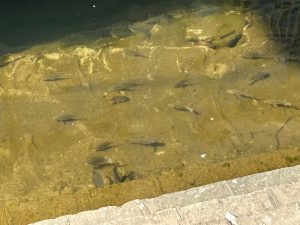On our recent visit to Egypt to do a Nile cruise, we were pleasantly surprised by the amount and diversity of the wildlife that lives on Egypt’s Great River. Some we had expected, some we definitely didn’t and some we expected but found out that they don’t exist (in that part) of the river anymore.
Indeed, ornithologists and twitchers would love it too, as well as, to another surprise for us, we reckoned train spotters/enthusiasts would too.
We discovered that a Nile River Cruise is a once-in-a-lifetime opportunity to experience the historical splendour of Egypt. Then we realised that the amazing creatures you can see today on the Nile were also of great importance to the ancient Egyptians. On a Nile trip, you will see them depicted again and again on tomb paintings, mummified, as statues – everywhere, in fact, that you see ancient art, you will also see animals. As the mighty River Nile is not only a historic landmark but also a haven for rich and quite unique wildlife. From graceful birds to fearsome predators, the Nile is home to an array of fascinating creatures that captivate all who explore its waters.
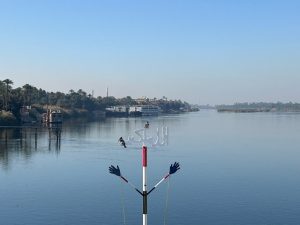
Wildlife of the Nile – Africa’s Living River Safari
The River Nile is more than the world’s longest river—it’s a moving lifeline, brimming with some of Africa’s most iconic wildlife. From colossal cows to dazzling kingfishers, every bend offers a new spectacle. Water buffalo, camels and donkeys are frequently seen grazing along the riverbanks. Jackal, mongoose and the desert fox may also be spotted in more remote and quieter areas.
The Nile Monitor is a reptile that can be found all the way to the Nile Delta. This lizard loves the water. The Nile River also supports a variety of fish species, including Nile perch, catfish and tilapia. Dragonflies, butterflies and many other insects are hugely abundant along the whole Nile. Attracting a plethora of birdlife, herons, egrets, ibises and storks are frequently seen wading in the shallows; while ducks, geese and other waterfowl are also common as well as many varieties of kingfisher. The Nile too, is a major migratory route, so you may spot cranes, swallows, warblers and finches among others during certain times of the year.
African Fish Eagle – The Voice of the Wild
With its white head, chestnut body and piercing yellow eyes, the African fish eagle is instantly recognisable. Its haunting call rings out across the river, a soundtrack to the Nile’s untamed beauty.
Watch as it soars high, then swoops with precision to snatch fish from the water—nature’s aerial hunter at its best.
African Buffalo – Strength in Unity
Muscular, horned, and weighing up to a ton, the African buffalo moves in herds that can number in the hundreds. Their sheer presence is striking, whether grazing quietly or engaging in boisterous sparring matches among the young.
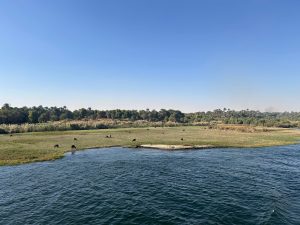
Small but Iconic – Pied Kingfisher & Ibis
The pied kingfisher hovers before diving for fish, its black-and-white feathers flashing in the sun—a bird so admired it’s carved into ancient art.
Equally symbolic is the ibis, sacred to the Egyptians as the form of Thoth, god of wisdom and writing.
Protecting the Nile’s Wild Side
Wildlife here faces threats from habitat loss to pollution. Conservation projects—reforesting riverbanks, protecting wetlands, and educating communities—are key to keeping the Nile alive with life. Every visitor who respects and supports these efforts helps safeguard its future.
Photography Tips for the Nile
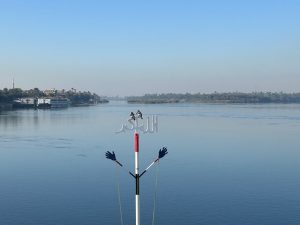
- Best Light: Early morning & late afternoon for golden tones and active animals.
- Gear: Telephoto lens for close-ups without intrusion.
- Approach: Stay quiet, keep your distance, and let the moment come to you.
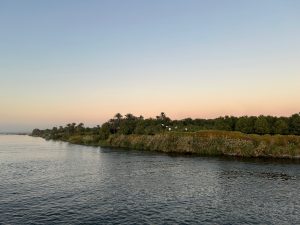
See it ALL from the Water
A Nile river cruise is like a floating safari. From your deck chair, spot bison on the banks, fish in the shallows and eagles overhead while drifting through some of Africa’s most stunning scenery.
Why the Nile Captivates
The Nile’s wildlife isn’t just scenery—it’s a living legacy. Every mammal, bird and fish is part of a story stretching back thousands of years. Visit, witness and help protect it, so future generations can share in its wonder.
What You (probably!) Won’t See on Your Nile Cruise
One of the most famous animals of the Nile is one that you probably won’t see on your cruise from either Cairo or Luxor to Aswan. You will probably be very glad of this too! The Nile Crocodile is still an omnipresent beast from Lake Nasser southwards but thanks to the High Dam, you will no longer find them any further north than that. This is partly due to access, the dam obviously creates a BIG barrier. Feeding habits too, as the flow of fresh fish are stemmed from the south now.

A big part of history in Egypt. The god Sobek has the head of a crocodile and there is even a crocodile museum in Kom Ombo, with well preserved and mummified Nile crocodiles from the past. Still in great numbers from Lake Nasser down, the Nile Crocodile is now consigned to the past in Egypt itself and that part of the great river. Reports of sightings and the odd escapee still occur in Egypt though, so keep em peeled!
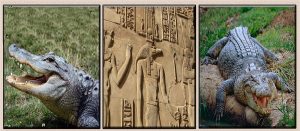
African Elephant – The River’s Gentle Giants
From central Africa south, African Elephants can be seen by the start of the Nile. Towering up to 13 feet tall and weighing 12000 pounds, African elephants are a breath-taking sight along the Nile. Herds gather at the water to drink, bathe, and socialise, offering unforgettable encounters for travellers.
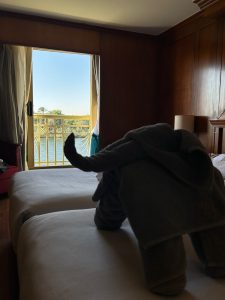
Led by wise matriarchs, these family groups display tender bonds—mothers guiding calves, siblings playing, and guardians watching over the herd. More than majestic, elephants shape the landscape, creating paths and promoting plant diversity wherever they roam.
Hippopotamus – Power Beneath the Surface
Also sub-Saharan thanks to the Aswan High Dam. Hippos may look relaxed in the shallows, but don’t be fooled—these 8,000-pound mammals are fast, agile, and fiercely territorial. Spending most of the day submerged to stay cool, they surface with dramatic yawns that reveal teeth over a foot long.
Their mix of calm elegance and raw power makes them one of the Nile’s most fascinating (and unpredictable) residents.
